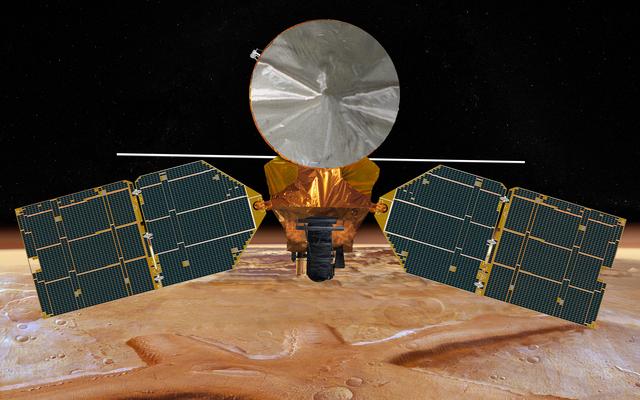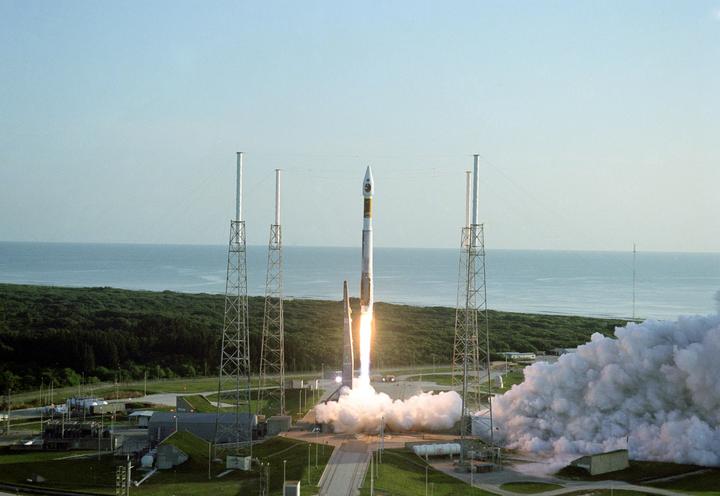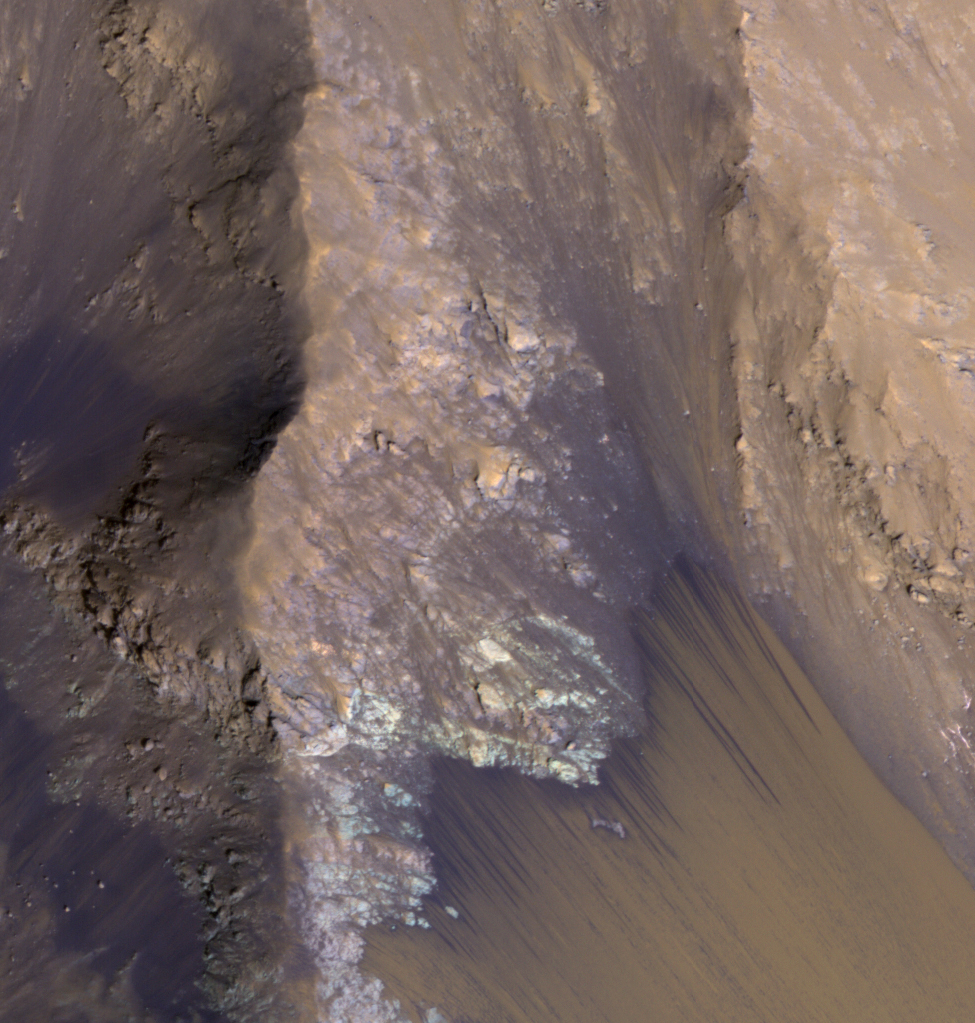
NASA’s Mars Reconnaissance Orbiter, aging and arthritic a decade after its launch, remains productive and is expected to be the primary pipeline for high-resolution maps of Mars for scientists and mission planners over the next decade.
Scientists who want to study Mars’ enigmatic history, tenuous water cycle and climate will continue to rely on the nearly $900 million MRO mission, and engineers charged with selecting landing sites for future Mars rovers, and eventual human expeditions, will use maps created from the orbiter’s imagery, officials said.
And the success of future landers, beginning with NASA’s InSight seismic probe next year, depend in part on MRO’s availability to relay data from the Martian surface to Earth.
“It’s taken for granted,” said Richard Zurek, MRO’s project scientist at NASA’s Jet Propulsion Laboratory. “Everyone assumes it’s going to be there.”
The mapping orbiter, which launched 12 August 2005, and reached Mars seven months later, does not get the headlines that NASA’s Curiosity and Opportunity rovers receive.
But many of MRO’s images are just as spectacular, revealing changes in Martian landscapes as the red planet goes through its seasons, Zurek said. Some of the snapshots returned by MRO’s high-resolution camera could even be considered artistic, he said.
MRO swooped into orbit around Mars in March 2006, used the Martian atmosphere to aerobrake into a near-circular operational orbit about 300 kilometres (186 miles) above the red planet, and then began an initial baseline science campaign in November 2006 scheduled to last two years.
The mission has won additional funding from NASA in two-year increments, and it is currently approved to operate through late 2016 at a budget of about $30 million per year.
But if the orbiter remains healthy, scientists expect MRO will remain at the forefront of NASA’s Mars programme well into the 2020s. It has enough fuel to keep going into the 2030s.
“Ten years after launch, MRO continues full science and relay operations,” said Kevin Gilliland, spacecraft engineer for the mission at Lockheed Martin, which built the orbiter under contract to NASA. “We’ve kept our operations efficient. We’ve been able to bring back an astonishing amount of science data — more than 250 terabits so far. Even after more than 40,000 orbits, the mission remains exciting, with new challenges such as taking close-up images of a passing comet last year and supporting next year’s InSight landing.”

Zurek said the most significant technical issue aboard MRO is in one of the spacecraft’s inertial measurement units used to determine the orbiter’s motion and orientation. Zurek said a laser inside one of the unit’s gyroscopes is showing signs of aging, and ground controllers are trying to coax the sensor along by switching to an identical backup unit.
In the meantime, engineers are working on changing the orbiter’s navigation logic to rely on star trackers in case both navigation sensors go down, Zurek said.
One of the gimbals used to point MRO’s power-generating solar panels toward the sun is also sticky, a sign of age-related “arthritis” aboard the spacecraft, Zurek said.
MRO also abruptly switches to its backup “B side” computer on occasion, temporarily interrupting scientific observations for a few days each time. Zurek said the orbiter’s ground team has learned to deal with the problem, which has escaped diagnosis with a root cause.
The spacecraft’s high-resolution camera, managed by scientists at the University of Arizona and known by the acronym HiRISE, is charged with surveying Mars for candidate landing sites for future rovers.
Imagery from HiRISE was instrumental in selecting Gale Crater as the destination for NASA’s Curiosity rover, and the camera is now snapping photos of prospective landing sites for a similar rover set for launch in 2020 and Europe’s ExoMars rover scheduled for liftoff in 2018.
NASA has also tasked MRO to snap photos of regions under consideration for human landings. The first formal workshop to discuss where astronauts should first explore Mars is scheduled for October in Houston.
“We’re going to have this information as we go forward in our programme to land things on Mars,” Zurek said in an interview with Spaceflight Now. “That just speaks to the quality and the impact of what those measurements have been to engineers.”
MRO’s capable science payload, which includes the HiRISE camera, has sent back 250 terabits of data so far. That’s equivalent to four months of non-stop high-definition video, according to NASA, more than the data haul from any other robotic probe in deep space.
Every week, MRO’s cameras, ground-penetrating radar, spectrometers and atmospheric sounder return more data than all other active Mars missions combined.
“From deep space, MRO returns the most data of any mission,” Zurek told Spaceflight Now. “That’s partly because we have such high-resolution instruments that we need that, and we’re also returning relay data (from Mars landers). That’s a small fraction of the total return, but nothing is insignificant in terms of the resources needed returning data from deep space.”
MRO’s arrival at the red planet in 2006 revealed a changing Mars, Zurek said.
“A major discovery is the diversity and ubiquity of water-related environments on Mars,” he said.
“We can observe and measure the movement of sand dunes,” Zurek said. “We see landslides on the planet because we have the resolution, and we can catch them at times when they are active.”
In the spring on Mars, the orbiter watches as the wintertime dusting of ice erodes away, erupting carbon dioxide gas in the atmosphere.
MRO has also likely discovered elusive liquid water bubbling at — or just just beneath — the Martian surface and streaming down steep slopes onto sandy fans. The scarce Martian atmosphere is too thin and frigid to sustain liquid water at the surface, but if the water is salty enough, it can remain in a liquid state in the right conditions, Zurek said.

The briny water — if that’s what it is — shows up in features called recurring slope lineae, which are “these long fingers on steep slopes during some of the warmest times of the year,” Zurek said. “They grow, the extend down the slope during that warm season, and then they fade away and finally they recur again.”
“Our best explanation for that is that these are brine flows,” Zurek said. “The surface is too cold for pure water to be liquid, but if you add salts, you can depress the freezing point.”
Zurek said he thinks scientists are close to confirming the flows are made of salty water. A confirming measurement could come from MRO’s spectrometer if the orbiter can observe a flow large enough to detect with the coarser-resolution composition instrument.
The seasonal water flows suggest there may be substantial water lurking just below the Martian surface in equatorial regions more accessible to astronauts than other water ice deposits at the poles.
The orbiter has also found evidence of Martian ice ages from layers in the planet’s northern polar ice cap, and a reservoir of frozen carbon dioxide in the southern ice cap that could have locked up a large fraction of the molecules from Mars’ atmosphere when it was much thicker in ancient times.
Despite MRO’s relatively good health, NASA is planning for a replacement. No NASA orbiters are slated to launch to Mars until at least 2022, but agency managers are working on an orbiter concept for the 2020s.
The European Space Agency is in the final stages of testing its own Mars orbiter, half of the two-part ExoMars program, for launch in January. The ExoMars orbiter will measure trace gases such as methane in the Martian atmosphere and provide data relay support for landers.
Launch opportunities to Mars come about every 26 months, when the planets are lined up to make a direct journey possible. The 2020 slot is taken by the next Mars rover, a modified version of Curiosity, so 2022 is the next chance for NASA to dispatch a U.S. orbiter.
“We know that the next set of missions will be replacing infrastructure,” said Jim Green, head of NASA’s planetary science division, in a presentation to the NASA Advisory Council in July.
Besides Earth, no other planet in the solar system boasts such a comprehensive fleet of spacecraft. Mars missions from the United States, Europe and India are driving across the surface, mapping the planet, tracking weather systems and probing Martian climate change.
Infrastructure upgrades aboard the proposed 2022 orbiter will include a radio to relay data and commands between Earth and rovers on the Martian surface. The orbiter will also likely carry a high-resolution camera at least as sensitive as the HiRISE imager, which can spot features nearly as small as an LP vinyl record, to extend the mapping capability to be lost with the end of MRO’s mission.
The new orbiter mission may also host a laser communications package to rapidly beam back science data to Earth several orders of magnitude faster than possible with existing radios. Ultra-efficient solar-electric propulsion pods could also be tested on the orbiter, according to NASA managers.
NASA officials said earlier this year that initial funding for the 2022 orbiter could be included in the agency’s next budget request to Congress in early 2016.
Email the author.
Follow Stephen Clark on Twitter: @StephenClark1.
